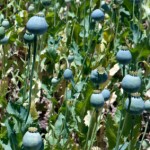I'm finally going to end this four-part series of posts on pain medications, their relatives and the issues with the "normal" prescription variety. Today I'm writing about legal drugs, used to control acute pain, chronic cancer-related pain (CCRP) and often for chronic non-malignant pain (CNMP). Of course they're also used for illegal purposes...frequently.
My series began to expand when I read an article in The Wall Street Journal in mid-December titled "A Pain-Drug Champion Has Second Thoughts." It told how Dr. Russell Portenoy, a New York academic pain specialist, Professor of Neurology at the Albert Einstein College of Medicine, trustee of the American Board of Hospice and Palliative Medicine and a past president of the American Pain Society has switched his point of view on pain pills for CNMP.
Twenty years ago he spear-headed the movement to both help those with chronic pain and to advocate the use of opioids that many physicians avoided, fearing their addictive properties. Those would include drugs such as OxyContin, Percocet and Vicodin (which a federal advisory panel recommended be banned in 2009), each of which rose to the top ranks of widely prescribed drugs. The opioids, when combined with over-the-counter pain medicine (e.g., aspirin, ibuprofen or acetaminophen) are in a less controlled status than the parent drug alone.
As far back as 1998 one prominent pain specialist urged be put higher on the controlled substance list which has a hierarchy from Schedule I (authorized for research only) to Schedule 5 (e.g., narcotic-containing cough meds). What's the difference? If a drug is in Schedule II it requires a manually signed prescription with no refills, whereas Schedule III drugs can be called in to a pharmacy for refills.According to the DEA, a Schedule II drug has a 30-day prescription length and one needs a new prescription for refills; Schedule III and IV drugs have no mandatory controls on length of prescription (insurers may limit), and one can receive five refills in six months.
As "Pain Pill Mills" spread widely across America people began to have second thoughts. An article from the WSJ six days ago told the story of "Pain Pills' Littlest Victims," babies born to mothers addicted to drugs such as oxycodone. These infants have withdrawal symptoms, require intensive care and typically cost Medicaid over $50,000. In 2009 there were over 13,000 of such newborns, requiring $720 million of hospital care. Hospitals have been ill-prepared for their care and had no fixed protocols for what is termed "neonatal abstinence syndrome." These newborns may be delivered to moms who have taken a variety of drugs: amphetamines, barbiturates; cocaine, benzodiazepines as well as opiates. Their care needs depend on what drug, how much and how long it's been used, how the mother's body metabolizes it and whether the baby was born prematurely. States including Florida, West Virginia and Kentucky have had considerable numbers of these afflicted newborns with hospitals in an area north of Tampa reporting up to 30% of their NICU patients treated for withdrawl from opioids.
Florida passed a law stating only doctors can operate pain clinics, so some owners have moved to other states without such restrictions. Deaths from two of the most commonly used opioids have decreased in Florida since the law went into effect, but Georgia's rules aren't as strict so a former used-car dealer from Florida opened a pain clinic there in 2010, hired two physicians through Craig's List and soon was dispensing RXs to 50 patients a day. Georgia had 10 such pill mills in 2010 and 125 in late 2012.
Overall accidental deaths from heroin overdoses increased slightly during the 2000 to 2009 time frame and cocaine-related deaths fell; both are under the 5,000 per year mark. But fatalities from painkillers increased markedly during the same period, to over 15,000 per year. A WSJ article published online Dec. 5, 2012 told the story of a 23-year-old woman who was one such casualty. Drug overdoses are now the most common cause of US accidental deaths, passing traffic-related casualties in 2009.
Our country spends roughly $15B per year combating illegal drug trafficking, mostly concentrating on other countries. It's time and past time to fight the pain pill problem here at home.





